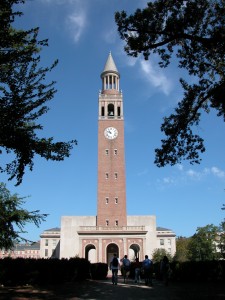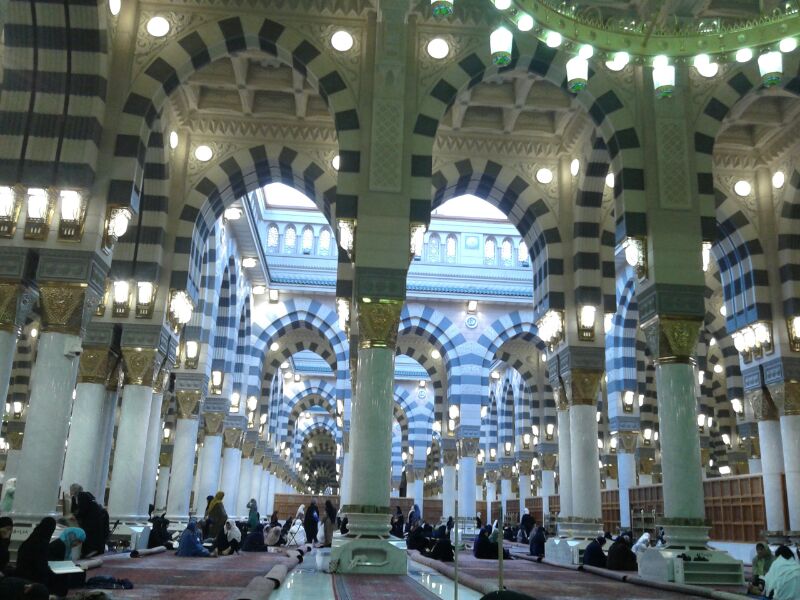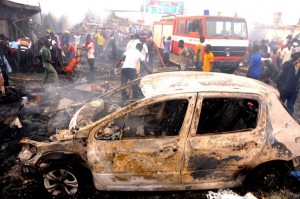In the late hours of Tuesday, February 11, social networks such as Twitter and Facebook were abuzz with news of a horrific and shocking story out of Chapel Hill, North Carolina. Three young people—Deah Shaddy Barakat, his wife Yusor Mohammad, and her sister Razan Mohammad Abu-Salha—all under the age of 23 and all students in the greater Raleigh-Durham-Chapel Hill area, were murdered in their home. No motive seemed immediately clear, but the facts of the case appeared reason enough to many who had taken to social media: the three victims were young Muslim Americans who practiced their faith proudly, and the shooter, who had turned himself in “without incident,” was white and an atheist.
Furor erupted across these social media outlets in the hours immediately following the attack, as many questioned why American mainstream media was not picking up the story. Ten, twelve, and even fourteen hours after the attack, still no mention had been made of the shooting on some of the nation’s biggest news platforms. Further anger surrounded the fact that President Obama took two days to issue any official statement. These lapses ignited a frenzied hashtag trend that quickly racked up thousands of tweets and retweets: #MuslimLivesMatter, an adaptation of the #BlackLivesMatter campaign to decry seemingly analogous gaps in media coverage of the nation’s reactions to cases of black men killed by white police officers.
The Muslim American community’s overwhelming response to the shooting, coupled with the responses from Muslim communities around the world, tells a story of shared persecution, anger, fear, and a declining trust in their own neighbors and country. These stories must trigger open and honest discourse about the experiences of Muslims, both in this country and worldwide. There must be discussion around their unfair representation in the media, the dehumanizing narratives that often surround their faith, and their desire for non-Muslims to attempt to understand Islam beyond the highly visible extremist versions.
Worlds Apart: Islam and Fundamentalism in the Media
Two months ago, in Peshawar, a city located in the northern region of Pakistan, nine armed men stormed the Army Public School and opened fire. Their bullets rained down on teachers and students alike, some as young as eight years old. In a matter of twenty minutes, at least 145 people were dead, 132 of them schoolchildren. 130 more were injured. Anecdotes from some survivors painted an even more horrific picture. Children wept as they recalled being forced to watch their teachers burnt alive. Others described the chillingly systematic way in which the gunmen roamed the auditorium and hallways, killing most with a single gunshot to the head. The Taliban claimed responsibility for the attack, and the entire nation of Pakistan and, indeed, the entire world, mourned the staggering loss of life.
It was the single deadliest terrorist attack in Pakistan’s history. And while it ran the headlines on most mainstream media outlets in this nation for a few days following the attack, it quickly faded from public discourse even as Pakistan was left utterly shattered and scrambling to concoct an appropriate response.
Fast-forward just over two weeks to the village of Baga in northeastern Nigeria. Over a period of approximately three days in early January, militants from the Islamic extremist group Boko Haram fought for control of the region surrounding the village by razing much of it to the ground, forcing most inhabitants to flee and slaughtering any who remained. Reports of bodies littering the street cropped up on the websites of humanitarian organizations such as Human Rights Watch and Amnesty International. Estimates about the death toll range from several hundred to over 2,000. Yet again, this attack broke records for the brutality and lethality of an attack by Boko Haram or any other Nigerian militant group. Yet again, the American news media picked up on the story several days late—after considerable public outcry—and addressed it almost as an aside before allowing it, too, to fade from discourse.
In the same timeframe of these attacks, two much larger stories occupied American airwaves for several days and weeks. First was the mid-December Sydney hostage crisis, in which a man, acting alone but citing Islamic scripture, held eighteen citizens hostage in a cafe in the middle of the Australian city. Tragically, three were killed. Second was the now notorious Charlie Hebdo shooting in Paris, in which three gunmen attacked cartoonists for blaspheming the prophet Mohammad, killing twelve. Both attacks spawned volumes of coverage, and, in the case of Charlie Hebdo, globally viral social media campaigns touting the value of free speech under the hashtag #JeSuisCharlieHebdo and a march for freedom in Paris that drew millions of demonstrators and several heads of state.
It wasn’t long, however, before the disparity in coverage between the two sets of appalling attacks—Paris and Sydney on the one hand, Peshawar and Baga on the other—drew the notice and the ire of many. What had prompted these news organizations to cover the two attacks in Western countries so thoroughly, while largely glossing over the ones in Nigeria and Pakistan? Was it a matter of political alliance—since France and Australia are two of America’s closest allies, did they warrant more attention? Did those in charge of setting the news agenda decide that their audiences would be better able to access and empathize with a story of terror in a Western city than a story of terror in nations that rarely make U.S. news for anything but terror?
And then there is the question of the march for free speech. The nine Charlie Hebdo cartoonists died exercising their right to unhindered creative expression, and for this the world was rightly outraged. But where was the global condemnation when over 100 schoolchildren died for exercising their right to go to school? Where was the indignation when potentially thousands of villagers died for exercising their right to live peacefully? Did they too not deserve a march for freedom, a day of vigils and memorials, solemn affirmations that the perpetrating groups had just waged the deadliest attacks in each of those nations’ history?
Whatever the answers to these questions, many Muslim Americans felt that a large contributing factor was implicit or subconscious hatred of and fear toward Muslims. “It’s not uncommon for the media to emphasize certain atrocities in the West to the West, and it’s easy to sensationalize certain people,” said Nancy Khalil, a doctoral student at Harvard researching Islam’s role in the West, in an interview with the HPR. The choice to cover Sydney and Paris so extensively, at the expense of adequately covering far deadlier attacks on human life in Baga and Peshawar, painted a grim picture of Islamic radicalism at odds with the Western way of life. Beginning with the War on Terror in the wake of the 9/11 attacks, this is the portrait of Islam that Americans have constantly been fed—Islam versus the West, barbarism versus civility, evil versus good. A clean-cut dichotomy that minimizes, if not eliminates altogether, the far greater extent of damage that Islamic fundamentalism wreaks on practitioners of Islam than on Westerners or non-Muslims.
“It’s become very easy to popularize media around events where Muslims are the culprits and non-Muslims are the victims,” Khalil said, citing the recently viral story about ISIS executing 21 Coptic Christians, at odds with the lack of such individualized coverage or attention given to ISIS attacks on entire villages or cities of Muslims. “[Muslims] are just the bad guys that are easy to point to now and easy to create a story around as easy villains … One can’t deny that these categories are being perpetuated.”
These inaccurate depictions about which Khalil and others have spoken in length are important and quite possibly dangerous. Many fear that with over a decade of digesting these types of stories and imagery, the average American has absorbed subliminal prejudices and fears toward followers of Islam. Despite the logical understanding that Islam is a peaceful faith, if these fears exist subconsciously, then no rational or intellectual understanding can mitigate them. And the numbers corroborate this trend. A Pew Research Center study from last year showed that Americans view Muslims more coldly than any other religious group. This notion of being consciously or subconsciously skeptical of Muslims, American or foreign, devout or not, has been dubbed by many as “Islamophobia.” The slow uptake in covering the Chapel Hill shootings, as well as the disproportionately extensive coverage of Islamic terror attacks against Westerners, could be representative of this phenomenon.
Terrorist or Lone Wolf: Double Standards of Representation

The University of North Carolina at Chapel Hill community is mourning the loss of three of its members.
An ongoing dispute about parking may have led to the triple shooting in Chapel Hill, according to statements made by local police the day after the students were killed. This conjecture about the shooter’s motive ignited even more controversy. To most, it was perfectly clear that the shooting had been a hate crime. “From a personal standpoint, not just to me or the Muslim community, but even to many outside it, it’s absolutely insulting and frankly a shame that the media could attribute this to parking,” said Mahmoud Saad, a member of UNC-Chapel Hill’s Muslim community, in an interview with the HPR. “I think it’s absolutely absurd, dehumanizing, and ridiculous.” Khalil, also a friend to Deah’s extended family, echoed these sentiments. “It’s such a disrespectful narrative. … It really disrespects the tragedy in a way that is offensive, and I think a lot of the Muslim community shares the sentiment.”
Amidst the pushback, police assured the public that they would investigate the possibility of a hate crime. If charged, the shooter could face punishments even more severe than those for a triple homicide. But this initial and ongoing hesitance to label the shooting a hate crime or even an act of terror represents a deep-seated double standard that, again, could find its roots in the Islamophobia so many fear suffuses the average American outlook.
“Terrorist is a racialized term,” read a viral Tumblr post that has collected thousands of likes and reblogs. “Meanwhile, white violence is excused, humanized, provided justifications for, no matter the extent of its damage, destruction and death toll.” Another similarly widely read post stated plainly, “The face of terrorism is a white man who can get away with murdering three Muslims without being called such.” Hundreds on Twitter and Facebook echoed these sentiments, as did Saad, who stated, “I think there is definitely a double standard. If the faiths had been reversed it would immediately be announced as terrorism.”
This luxury to be viewed as separate from their religious ideology is often not afforded to Muslim criminals, which strengthens the implicit and explicit associations made between the word “terrorism” and the faith of Islam. If the only “terrorists” that Americans see on the news are radical Islamists waging jihad against the West, the word begins to carry a deeper and more sinister connotation. It begins to become synonymous with the faith with which it is so frequently associated. “Every time you turn on the TV, you see this bombardment of Islamophobic stories and vitriol,” said Omid Safi in an interview with the Huffington Post. “It’s hard not to see [such stories] as connected with violence against people of color and marginalized communities.”
This explains the outrage when mainstream media in the United States continue to insist that, until proven otherwise, the Chapel Hill shooter lashed out only because of a disagreement over parking. It explains the outrage at the immediate default defense given to so many “lone wolf” white criminals in this nation: that the act was a result of mental imbalance or illness. These attempts to divert conversation away from the bigotry of the Chapel Hill shooter are painful to the Muslims who feel as though they would never be afforded the same benefit of the doubt—who feel as though their faith is under attack any time another radical proclaiming ties to Islam kills a Westerner.
The Desire to be Treated as Human
However, many news officials and ordinary citizens alike have continued to insist either that the allegations of hate crimes be stymied until there is sufficient proof of a killer’s motivation or that the public spend time honing in on a true definition of the term“hate crime.” But trying to silence Muslims who insist that the event at UNC-Chapel Hill was a straightforward hate crime misses an enormous point. Their anger comes from fear, and their fear is our fault as non-Muslims. Is this a culmination of years of feeling subtly and at times overtly persecuted? What actions have we taken to make an entire population in this country feel unwanted, ostracized, and targeted? Does the inconvenience or irksome nature of people’s “overreaction” and loose usage of the word “hate crime” compare to the fear that Muslims harbor that they could, like the Chapel Hill victims, lose their life because of their faith? Rather than debating the linguistic and rhetorical implications of the term “hate crime,” these questions should form the basis for renewed, vigorous discourse. How are Muslim Americans being treated both by civil society and by the media and how are implicit biases against Islam being advanced?
Despite these disheartening trends and the tragedy of the shooting, much of the Muslim community has responded with hope that this event will accomplish just that: a national, humanizing conversation about our Muslim neighbors. “I think there has been a transformative shift around this specific incident,” said Saad, describing how Deah Barakat especially has been unanimously praised and celebrated for his charitable character, portrayed in a human light that transcends the prejudices around his faith. “It is difficult and painful that it took the murder of someone like Deah for this to happen; for the media to paint this picture and to eventually pay attention. It’s so sad and it’s really hard but I felt like it was necessary for it to be someone who was such a model American citizen for a potential transformative shift to occur.”
“As an American Muslim here, I am not a headline. I am not different nor is any hijabi woman. I’m not a label,” said Myra Waheed, another member of the Muslim community at UNC-Chapel Hill, to the HPR. “This discussion can’t be behind your cup of coffee in the morning or behind the news you hear. It must be a conversation with your neighborhood, community, classmates, and teachers.” In the wake of this tragedy, it is of crucial importance that we acknowledge and elevate these voices and honor their requests; that we endeavor to listen to their stories and pay attention to the harmful narratives being advanced in much of the media we consume. As a result of this media coverage, to many Americans, all terrorists are Muslims—full stop. While that misperception alone is frightening, the greater fear, confirmed to many by the Chapel Hill shooting and its aftermath, is that some Americans have also begun to believe the converse: all Muslims are terrorists or are apologists for terrorism. Full stop.
Photo Credits: Mosque: بلال الدويك, Wikimedia Commons; Boko Haram Attack: Tan Khaerr, Wikimedia Commons; UNC-Chapel Hill: Ildar Sagdejev, Wikimedia Commons

